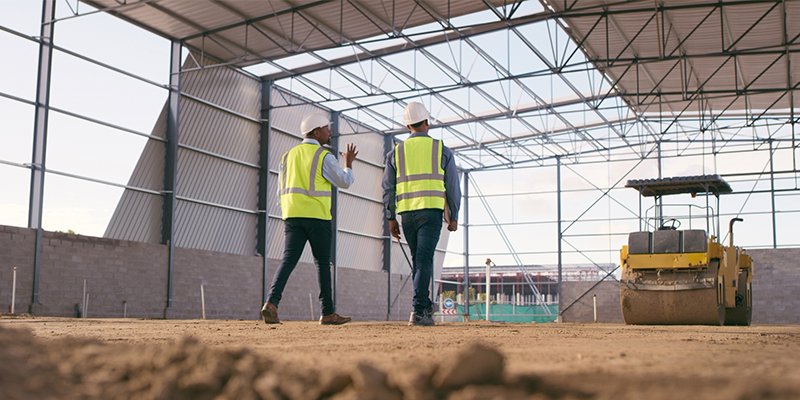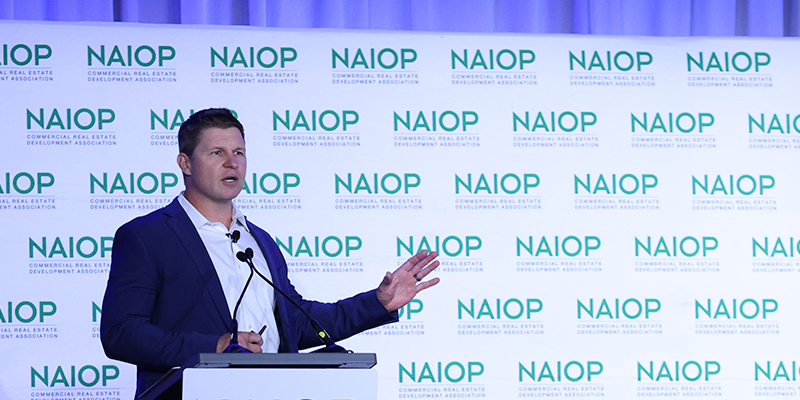Major themes dominating the attention of commercial real estate development professionals in 2023 included capital markets, financing and industry outlooks, according to the most-read Market Share posts this year. While concerns about usage of office space persist, blog readers were primarily drawn to posts about industrial real estate – often where industrial real estate intersected with capital markets. Read on for the top 10 and catch up on any pieces you missed.
- Adopt or Adapt: Learning from Amazon’s Real Estate Approach
At NAIOP’s CRE.Converge this October, Amazon Vice President for Worldwide Real Estate Daniel Mallory sat down for an in-depth chat in front of an audience of 1,500 commercial real estate leaders. Jean Kane, former CEO of Colliers International-Minneapolis St. Paul and the incoming chair of the NAIOP Research Foundation, asked Mallory about his perspectives on everything from the company’s sustainability efforts to today’s market challenges to future workforces and beyond. - Industrial Real Estate and the Economy: Where Are We Headed?
“Technology is going to be among the most important things that impacts the industrial sector,” began Rebecca Rockey, economist and global head of economic analysis and forecasting at Cushman & Wakefield, during the I.CON West’s keynote session this March. “The industrial sector stands to be the first industry to experience that adaptation as the nature of our economy and demographics change.” - Financing Design Starts Long Before Construction Begins
“Where there’s a will, there’s a way.” This adage has never been more relevant for developers looking to finance new building projects, said Yonah Sturmwind, commercial lending specialist originator, Alliant Credit Union, and Kathy Kozak, vice president, strategy & corporate finance, Trez Capital, in a post this March. Given the economic outlook and difficulty of securing financing through traditional capital providers, borrowers may need to seek out alternative lenders to creatively finance their projects, the authors said. - Cutting Through the Uncertainty: CRE Leaders Share Economic, Industry Outlooks
“We’re all aware and we’re all feeling the impact of the most aggressive financial tightening in the country since 1980,” opened Hessam Nadji, president and CEO, Marcus & Millichap, on a company-hosted webinar early this year. “We haven’t seen the Fed being the problem in four decades, in that they’ve always been to the rescue in an economic crisis.” - The Capital Markets Outlook for Industrial Real Estate
“Industrial is one of the brighter spots in the capital market today – I think we can all agree on that,” said Jim Linn, executive managing director, Newmark, at I.CON West this March. “We are experiencing some cooling in the absorption of industrial real estate,” he said, but given that the amount of absorption last year was second only to 2021, “even a cooling is going to be a good year for absorption and hopefully rental growth in the capital markets world.” - California’s Title 24 Introduces New Solar Requirements for CRE
California’s Title 24, the state’s energy code, has required solar for all low-rise multifamily projects since 2016, but new provisions have gone into effect this year, impacting any projects permitted since Jan. 1, 2023. To help navigate the regulatory landscape and explain how solar and energy storage can benefit building owners and developers, Rachel McCafferty, director of business development for CalSolar Inc., shared her expertise during a NAIOP webinar on the topic this spring. - Peeling Back the Onion of Capital Markets and Cold Storage Development
“Less than 2% of industrial space today is cold storage, and it probably needs to be at 15%. We’re not even in the first inning,” opened economist KC Conway in a keynote session at NAIOP’s I.CON Cold Storage conference this September in Atlanta. Using the analogy of peeling back an onion, Conway identified four cold storage and capital markets “layers” to “see what makes us sweat and what makes us cry.” - Industrial Real Estate and the North American Supply Chain Revolution
Industrial real estate might have been one of the strongest-performing property types out there in recent years, but it is far from immune to change. During a panel held at NAIOP’s CRE.Converge this October, Chad Griffiths, MBA, SIOR, partner and associate broker at NAI Commercial Real Estate, spoke with Matt Carroll, senior associate at Avison Young, about what’s in store for industrial properties in the coming years. - Capital Markets: Can’t We All Just Get a Loan?
High interest rates combined with persistent inflation have created the toughest commercial real estate financing environment since the Global Financial Crisis. Post-pandemic vacancies in commercial real estate and shifts to digital retail and work have added more considerations for prospective buyers and sellers. At NAIOP’s CRE.Converge conference this fall, experts discussed the current landscape of commercial real estate loans throughout different sectors, such as multifamily, retail and office spaces. - The State of the Markets for Industrial Real Estate
“Volatility and uncertainty” describe the current state of the markets, according to Tom Griggs, managing director and head of industrial & logistics for the East at Hines, with the past 12-18 months presenting a difficult environment. Griggs led an expert panel discussion on the outlook for the industrial real estate capital markets at NAIOP’s I.CON East this June.
Follow NAIOP’s Market Share blog in the year ahead so you don’t miss any news and perspectives from commercial real estate leaders. Subscribe to the blog (enter your email in the box on the top right here) to have new posts delivered directly to your inbox.








